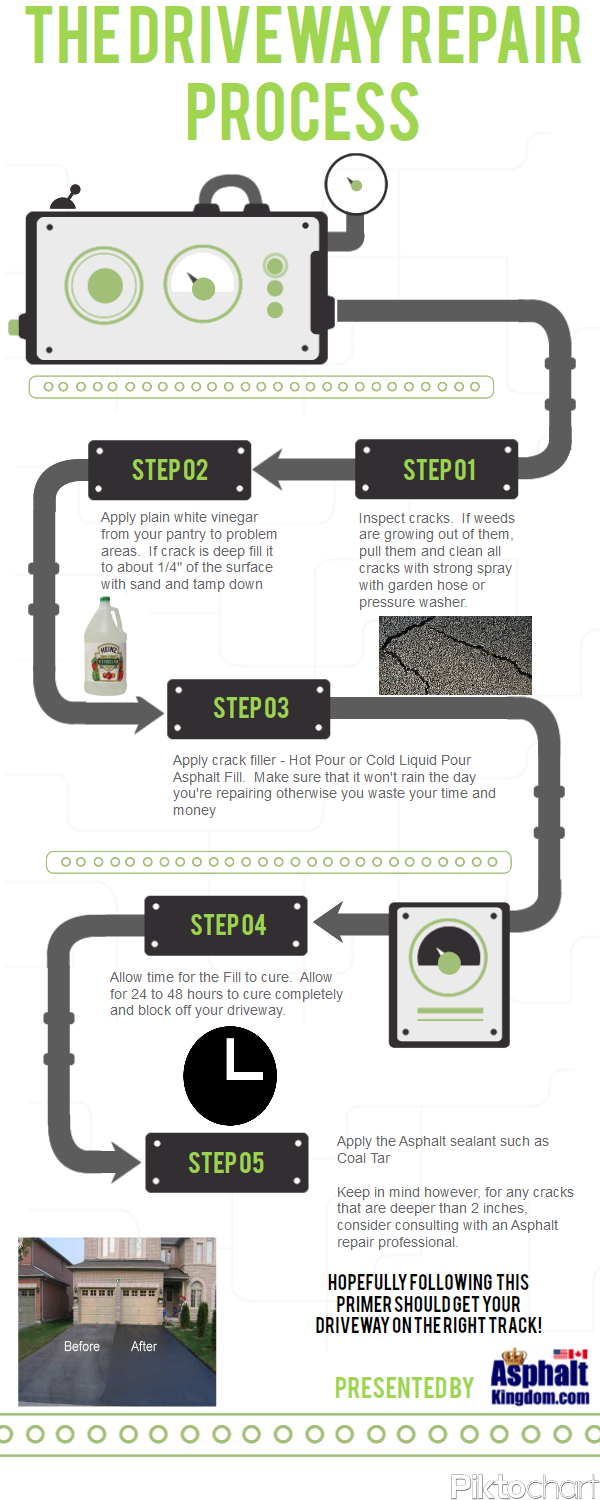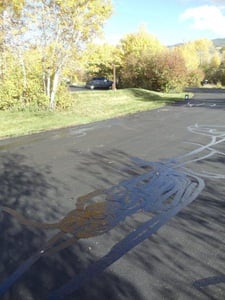
5 Major Trip and Fall Cases Every Property Manager Should Know
Learn from major trip and fall cases and see what property managers can do to prevent hazards, ...
Driveway repair is a crucial part of home maintenance. It's critical to keep up with annual maintenance if you want to preserve the life of your asphalt while protecting your home's curb appeal. Treated properly, an asphalt driveway can last up to 30 years without needing replacement. So where do you begin?
Here's a free, fast and easy test you can try at home: pour some water on a well-trafficked part of your blacktop driveway and watch what happens. If the water beads on the surface, your asphalt is in good shape. If it doesn't, though, you have problems you should address as soon as possible. If water is seeping into the asphalt, it's causing damage.
In warm seasons, water will erode the pavement – and the foundation – causing it to crack. As the weather gets colder, a freeze-and-thaw cycle will begin, and the expansion and contraction will increase the size of the cracks. As the foundation becomes compromised, you've gone from looking at spending a few hundred dollars repairing your driveway to thousands of dollars replacing it.
Aside from the water test, look for obvious signs of trouble: cracks in the driveway can allow vegetation to spring up, further eroding the foundation. Potholes will eventually form if the cracks aren't treated, and they're another sign of trouble. And a badly faded sealcoat surface where all the stone aggregate is showing is another sign that it's time to sealcoat. Heat, grease, gas, oil spills and salt stains will all work to eat away at your driveway. Don't worry: a fresh coat of sealer can protect your driveway for years.
Asphalt is a tar-like material found in petroleum deposits.
When heated and mixed with crushed rock and other substances, it becomes a somewhat smooth texture that can support even the heaviest of vehicles. It’s commonly used on public roads, as well as on the driveways of many private residences. Asphalt is similar in chemical composition to motor oil and gasoline. If these items get spilled on the surface, they bind with it, leaving stains.
Sealing is the only way to ensure that your drive looks as good as it can for as long as it can. Driveways that aren't sealed develop cracks faster and need to be replaced. So, sealing is a money-saving choice.
Everything from earthquakes and freezing temperatures, to tree roots and poor asphalt maintenance can cause asphalt to crack.
Sealing with a professional grade asphalt sealer is the best way to prevent cracks from occurring in the first place.
For brand new driveways and parking lots, it's important to wait at least 90 days for the material to be fully cured and hardened before sealing the surface. Once the 90 days have passed, seal the asphalt as soon as possible.
After the initial coating, you should seal whenever you repair cracks or potholes. Higher quality asphalt driveway sealer will last for three to five years before a new coat is needed, depending on the amount of traffic the area receives and the amount of UV damage it gets.
Low quality sealants may need to be replaced more often. The low quality products are cheaper, but they need to be replaced more often. The layers will start to crack, flake and peel much sooner than the better quality products. The higher quality sealants are worth the money.
Summer is the best time to seal. In general, the temperature must be above 50 degrees for the sealants to cure properly.
Most professionals recommend an asphalt driveway sealer that has sand mixed in with it. The sand improves durability and traction.
The cure time depends on the kind of sealcoating you decide to use. Most professionals recommend waiting at least eight hours before driving your car on the coated surface. In the cooler months, it may be necessary to wait for 36 hours with our sealer; with hardware-store amateur sealer, drying time is between 36 and 72 hours.
Commercial grade sealants are definitely required for airports runways and they're also needed in parking lots with lots of traffic. If it's good enough for the mall, you can bet that a commercial-grade asphalt driveway sealant will do an excellent job in your driveway, too!
Learn which products you need and which items from around the house will help you get the job done right.

With a few simple steps and asphalt repair products, you can bring your blacktop back into shape, and, more importantly, prevent further damage. Begin by checking the weather – ideally you'll have two sunny days in a row, and temperatures not dipping below 50°F. Once you've picked your day, pick out an old outfit (crack filler and sealer permanently stain clothing and shoes.)
There are four steps to repairing your driveway.
Do not skip this step! Asphalt sealcoat can repel the elements, but it needs to be applied on a sound surface, and that means filling in cracks and holes. It's a simple process.
Crack Repair Materials:
Crack Filling
 If you're using cold liquid crackfiller, shake it to ensure it is thoroughly mixed, and then fill the crack flush with the top of the asphalt surface. You don't want to overlap too much or the seals will show through the sealer.
If you're using cold liquid crackfiller, shake it to ensure it is thoroughly mixed, and then fill the crack flush with the top of the asphalt surface. You don't want to overlap too much or the seals will show through the sealer.
If you are using the hot rubberized crackfiller, heat your melter or kettle and insert the brick of crackfiller. If you are using Asphalt Kingdom's Crack Fill, you can use a direct-fire kettle or an oil-jacketed melter. Cheaper crack fill can only be used in an oil-jacketed machine.
Once the product is melted, apply it at a walking pace over all your cracks a half-inch wide or smaller. * NOTE! If the crack is wider than a half inch, or if it is deep, you should first top up the crack with a mix of gravel and sand packed firmly in the crack. Fill to within a half inch of the asphalt surface, and then fill the rest with hot pour crackfiller.
Allow time to cure for a few hours before sealing.
Pothole Filling
 You should have already cleaned the edges of the pothole during your cleaning session in step one, but if you haven't, make sure you do that. Then cut open the bag of asphalt patch, and pour it into the pothole. Our cold patch asphalt repair product will fill a hole one inch deep by four feet in diameter.
You should have already cleaned the edges of the pothole during your cleaning session in step one, but if you haven't, make sure you do that. Then cut open the bag of asphalt patch, and pour it into the pothole. Our cold patch asphalt repair product will fill a hole one inch deep by four feet in diameter.
First apply and force the fill product into all the voids, making sure it is tightly packed. Then add more so it’s slightly mounded above the surface of the blacktop. Now cover the area with the plywood, oiled side down. Drive over the wood with your car to firmly tamp down the crack filler/asphalt patch.
Asphalt Kingdom’s 12.5 gallon applicator is the best hot pour crack filling system on the market. It's capable of filling 25 feet of cracks in just 15 seconds!
The next step in the process is to seal the patched and filled surface, providing a layer of protection from the elements and greatly increasing your home's curb appeal.

Tape off the area with caution tape and allow it to dry for at least four hours before you walk on it and at least eight hours before you drive on it. Letting the area dry overnight is best.
Choose a Spray System if...
Choose a Squeegee if...
After all your hard work, it's important to maintain your driveway going forward.


Learn from major trip and fall cases and see what property managers can do to prevent hazards, ...

Handling asphalt sealer doesn’t have to be tricky—learn 10 pro tips on buying, mixing, storing, and ...
-2.jpg?width=360&height=202&name=Blog%20Images%20(39)-2.jpg)
Debunk the top asphalt sealcoating myths and learn how proper sealing saves money, boosts safety, ...
sales@asphaltkingdom.com
Mon–Sat, 8:00am–8:00pm ET